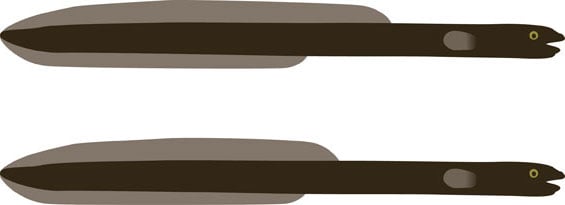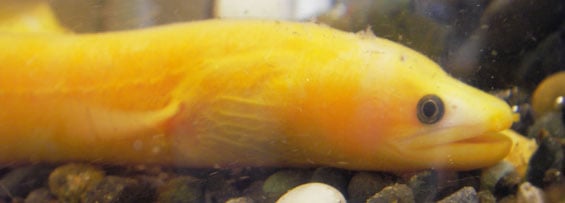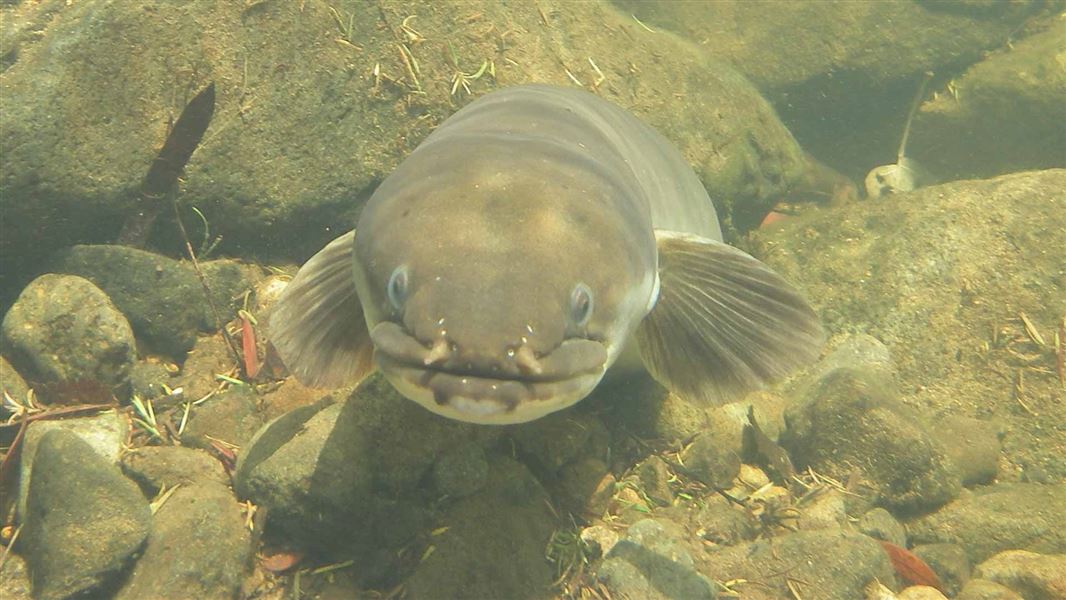At first glance, all New Zealand freshwater eels look the same, but there are three species:
- Longfin eel. Conservation status: At Risk- Declining. Found only in New Zealand.
- Shortfin eel. Conservation status: Not Threatened. Found in New Zealand, Australia and some Pacific Islands.
- Spotted eel. A visitor from Australia.
With a little bit of knowledge and a keen eye, these fascinating creatures are easy to tell apart.
What’s the difference?
The two main species of freshwater eel found in New Zealand are the longfin eel (Anguilla dieffenbachii) and the shortfin eel (Anguilla australis).
On a longfin eel, the dorsal (top) fin extends a lot further forward than the anal (bottom) fin. The dorsal fin of a shortfin eel only extends a little further forward than the anal fin.

Diagram of eels with longfin eel at top and shortfin eel below
A third species, the spotted eel (Anguilla reinhardtii) is an occasional visitor from Australia.
A species in decline
The longfin eel is ranked as ‘At Risk - Declining’ in the New Zealand Threat Classification System listings (2014). It is only found in New Zealand. The shortfin eel is ‘Not Threatened’ and is found in New Zealand, Australia and some Pacific Islands.
Longfin eels, as well as being rare, are less able to cope with changes to their environment than their shorter-finned relative. They are heavily affected by human activities, such as pollution, the building of dams, loss of vegetation near their habitat, and overfishing.
Give the longfin a helping hand
- Avoid catching them, and if you do, return them to the water unharmed.
- Fence stream banks to keep stock out.
- Plant trees along stream banks to create shade (certain trees also provide a food source).
- Don't let pollutants enter waterways.

Longfin eel skin folds - big loose wrinkles
What to look for

Shortfin eel skin folds - smaller wrinkles
Anyone who has handled an eel out of water knows that they will not usually stay still long enough to allow you to measure their fins! So some ‘rules of thumb’ can be used to identify them.
An eel is probably a longfin if it’s:
- very dark in colour
- more than a metre long
- living in a high-country river or lake, or a clear, cold, spring-fed stream at any altitude.
If in doubt, there is a very reliable way to tell the difference (see images on right):
- a longfin’s skin forms big, loose, obvious wrinkles when bent
- a shortfin’s skin wrinkles are much smaller.
If you're really lucky you might spot a rare 'golden' longfin. This change in colouration is caused by a loss of dark pigments, allowing yellow pigments to become clearly visible.

Golden longfin eel
Image: Mike Joy ©
Summary of differences
| Shortfin eel | Longfin eel |
|---|---|
| Found in New Zealand, eastern Australia and some Pacific Islands | Found only in New Zealand |
| Range of colours, often light brown, olive | Usually dark brown/black |
| Grows up to 1 m long and weighs up to 3.5 kg | Often more than 1 m long and can grow up to 2 m long, and can weigh up to 20 kg, sometimes more (although this is now very rare) |
| Small wrinkles on the skin when bent | Big, loose wrinkles on the skin when bent |
| Lives mostly in lowland areas | Lives at a wide range of altitudes, including very high elevations |
| Relatively pollution tolerant | Relatively intolerant of pollution |
| Lives for an average of 18–23 years and up to around 60 years | Lives for an average of 35–52 years and up to 100 years, sometimes more |
Eels in your community
Wild eels can be hard to spot, so many wildlife parks and zoos have ‘tame’ eels you can get up close to and sometimes even feed. It’s a great way to educate the whole family about how special and unique New Zealand’s freshwater eels are.
Ensuring that the New Zealand longfin is still around in the future would be a great gift to offer the next generation.
Did you know?
New Zealand freshwater eels can live up to 100 years and breed only once at the end of their lives. In order to breed, they undergo mass spawning migrations, leaving the familiarity of lakes and rivers to swim all the way up to the subtropical Pacific Ocean, where they spawn en masse in very deep water.
You can also view this information in a brochure: Freshwater eels in New Zealand (PDF, 817K).
